|
International Mobile Telecommunications – Next Generation
New Year Report – 2019
The countdown has begun. The ball is dropping. In about a year, the newest versions of 802.11 and 5th generation cellular technologies will emerge. As network architects and engineers, it’s important for us to understand the strengths, weaknesses, and topological boundaries of both these wireless, data communications protocols.
In previous chapters of Future-Fi we’ve discussed the IEEE 802.11 Working Group and have taken a detailed technical look into the features and services we expect to see with the release of 802.11ax (aka Wi-Fi 6) and beyond. But the protocol specifications being developed for next generation cellular communications will also have a major effect on how our end users will connect and do their jobs.
One Wireless World?
The cellular industry has always taken a global view of connectivity. In fact, the specifications for each successive generation of cellular technology beginning with 3G, have been determined by an agency of the United Nations, the International Telecommunications Union – Radiocommunications Sector (ITU-R) and its Working Party 5D (WP 5D). WP 5D is responsible for the high-level radio system aspects of International Mobile Telecommunications (IMT) systems, comprising the IMT-2000 (3G), IMT-Advanced (4G) and IMT-2020 (5G) specifications.
3GPP/IEEE
These cellular technologies have evolved from the early (1982) digital cellular protocol (2G) known as GSM (originally Groupe Special Mobile is now Global System for Mobile communications) controlled by the Conference of European Posts and Telegraphs (CEPT). While the ITU-R WP 5D develops the general guidelines for cellular evolution, the physical network architecture and radio interfaces are created by other technical organizations, such as the Third Generation Partner Project (3GPP) and IEEE 802 LAN/MAN Standards Committee.
ETSI/FCC
Because GSM and its derivatives began as European cellular technologies, they are still greatly influenced by the European community, even though they have grown into a de facto, worldwide, cellular standard. The organization that provides regulatory controls and develops network standards for the European community is called the European Telecommunications Standards Institute (ETSI). By enforcing regulatory requirements for all European Union (EU) members, ETSI has enabled a harmonized radio environment for global mobile communications and roaming, to which many non-EU nations have also subscribed. ETSI’s current frequency usage requirements for use of 5 GHz unlicensed band in the EU is documented in the EN 301 893 v2.1.1 standard. Historically the ETSI requirements have been more restrictive than the North American, Federal Communications Commission (FCC) or Industry Canada (IC) requirements, so conformance to the ETSI rules has had a “worst case effect” on global systems design.
A fresh batch of alphabet soup
As if wired and Wi-Fi networking didn’t already have enough acronyms and terms to digest, the cellular world dishes out another huge glossary for us to gnaw on. Common Wi-Fi terms such as Access Point (AP), Basic Service Set (BSS), and wireless LAN (WLAN) each have an IMT-2020 or 3GPP counterpart in cellular jargon, but there are also some additional topological concepts in cellular that aren’t equivalent in Wi-Fi. For instance, the term RAN (Radio Access Network) is like the idea of a wireless local area network (WLAN) in that it allows the connectivity of User Equipment (UE) to a Core Network (CN) by way of wireless base station (eNodeB).
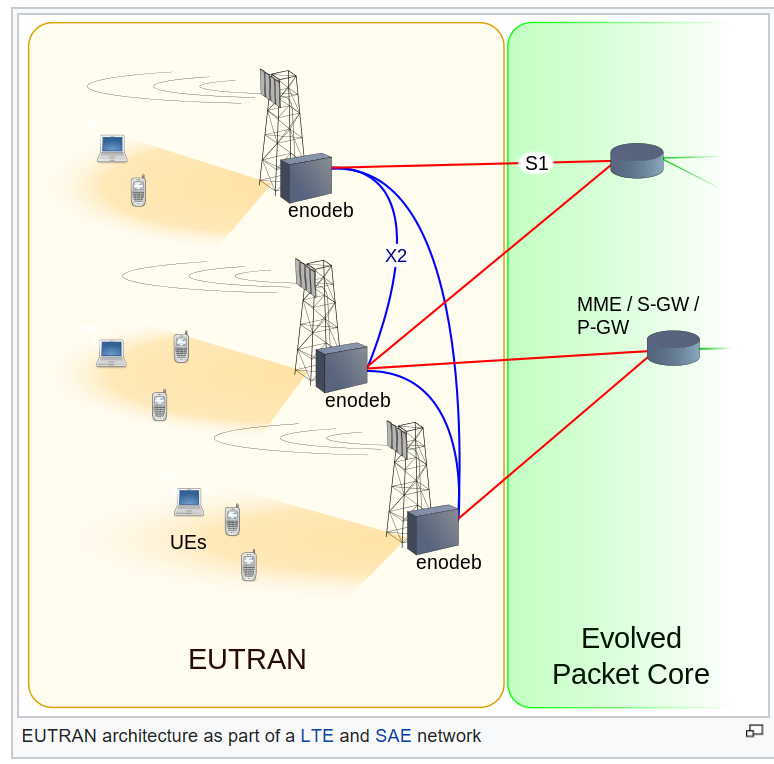
LTE EUTRAN Architecture – source WikiPedia
(Wi-Fi Equivalents: UE = Client STA, eNodeB = Access Point)
Prepare to face the Multi-RAT
But a 3GPP RAN is slightly different in that it may support multiple radio access technologies (RAT) simultaneously, such as WiMAX and LTE. This ability is called multi-RAT support. Currently, the IEEE 802.11 Working Group is trying to gain recognition for 802.11ax as an official, IMT-2020 RAT (much more on this below). In 3GPP terms, the segment of a RAN that includes an 802.11 RAT is called a radio local area network (RLAN instead of the Wi-Fi term WLAN).
3GPP Releases
3GPP versions of the LTE protocol are formally called, “Releases”. In March 2016, the 3GPP published Release 13 of the LTE (Long Term Evolution) protocol. This was the first standardized version of LTE that provided compliance with the ETSI EN 301 893 requirements for unlicensed band usage in the 5 GHz band for the EU. This is also sometimes referred to as LTE-LAA (Long Term Evolution – License Assisted Access). One of the major differences between LTE-LAA and the non-standardized implementation of LTE in unlicensed bands that was previously deployed in the U.S. (LTE-U), was the requirement of a simplistic “Listen-before-talk” (LBT) procedure prior to the LTE transmission. This is similar to, though not as sophisticated as, Wi-Fi’s Clear Channel Assessment (CCA) stage of the Distributed Coordination Function (DCF) method of collision avoidance.
Currently, 3GPP technology is at Release 15 with Release 16 in development. Release 16, will also be known as “New Radio – Unlicensed” (NR-U) and is targeted for publication in 2020 to coincide with IMT-2020. As discussed below, two 802.11 standing committees are now attempting to negotiate with 3GPP to create better coexistence between Wi-Fi and Release 16 of the LTE standard.
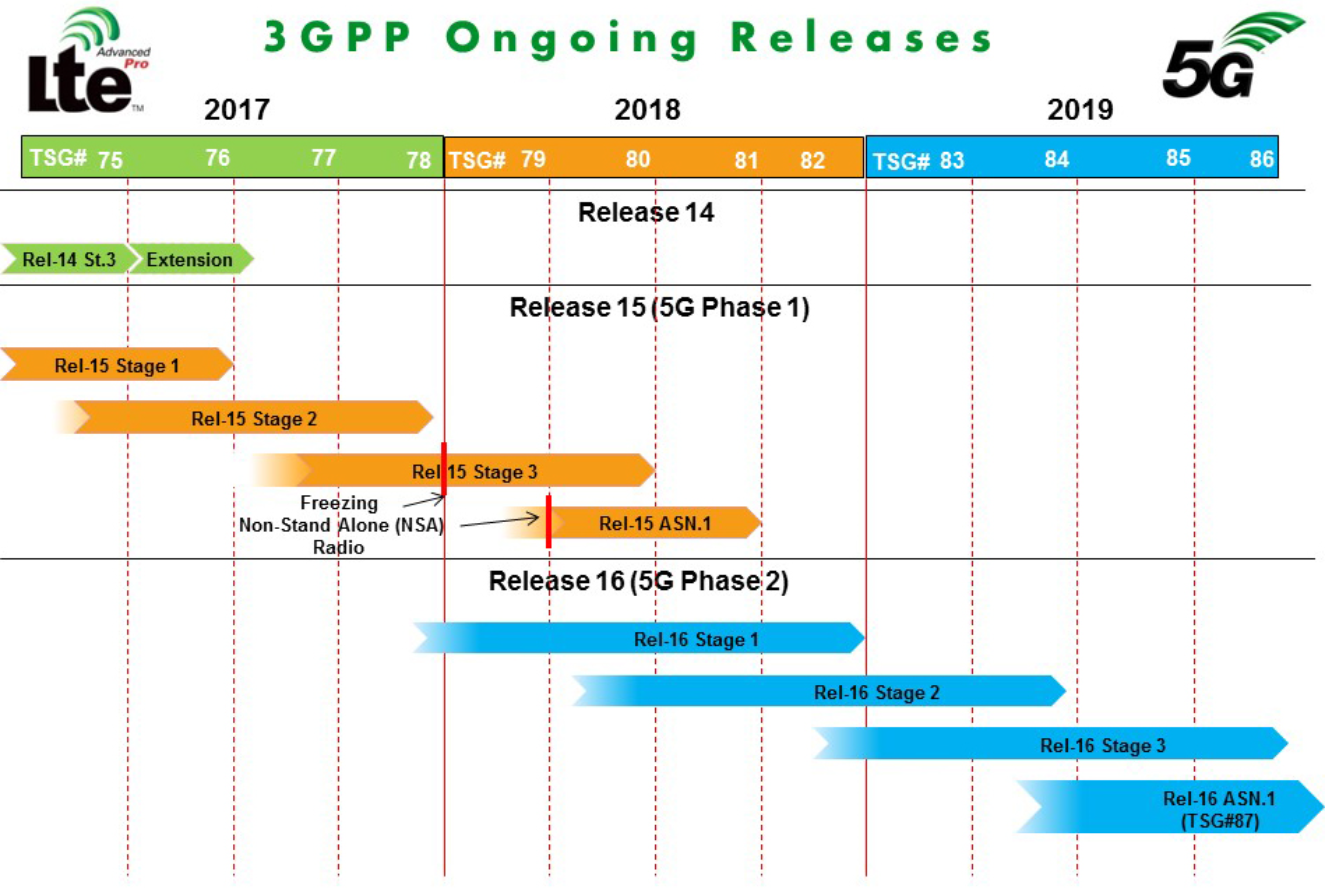
3GPP Ongoing Releases – Image Courtesy 3GPP
http://www.3gpp.org/specifications/67-releases
We Say, They Say …
Since the original announcement by the LTE-U Forum in 2015, that they intended to use the 5GHz unlicensed frequency range for cellular offloading and overflow, there has been a battle for the bands over the issue of fair coexistence in the unlicensed channels. Basically, the Wi-Fi community has warned the cellular industry of the potential for service disruption and performance degradation to Wi-Fi users in areas where LTE-LAA is operating nearby.
The cellular industry responded by saying that their in-house testing proved that LTE-LAA is no more disruptive to Wi-Fi than what would be experienced by adding another Wi-Fi BSS in the same vicinity, on the same channel and therefore they would just go ahead and do it.
|
Wireless Battle of the Bands — Catch-up This articles focuses mostly on the current and future issues concerning cellular and WLAN coexistence in the unlicensed radio bands. Use the following links to catch-up with the bitter back and forth that led to LTE Release 13. Start with the Wi-Fi Alliance summary perspective from 2015. This well-written report commissioned by the WFA can e accessed through the Wi-Fi Alliance’s Resource Center (registration required). https://www.wi-fi.org/downloads-registered-guest/wp_SenzaFili_LAA_201510.pdf/25232 To read the details of the arguments between Google and Qualcomm read these…
For even more links check out the bottom of the LTE-U Wikipedia page: https://en.wikipedia.org/wiki/LTE_in_unlicensed_spectrum |
WLAN Design Best Practices 101
The truth is somewhere in the middle. It’s true that LTE-LAA takes some basic precautions to reduce its harmful affect on Wi-Fi. And there is evidence that LTE-LAA transmissions, at least in the downlink, are only as corrosive as an additional Wi-Fi BSS added to the same channel.
But, one of the primary objectives in designing an enterprise WLAN is to carefully separate channel assignments between the BSS’s in order to reduce the negative effects of co-channel interference (CCI). CCI is a well-known degrader of end-user performance in WLANs. So, the statement from 3GPP that coexistence with a nearby LTE-LAA RAN is no worse than what you’d get by adding another BSS on the same channel isn’t very insightful. As more and more 5G RANs are deployed (outside the control of wireless network designers) into the small, medium, and enterprise LAN spaces, we should expect to see the performance of 802.11 WLANs be more affected. For that reason, it’s important that the views of the Wi-Fi community be expressed within the working groups that are designing the IMT-2020 RAN and RAT specifications before they become hardened.
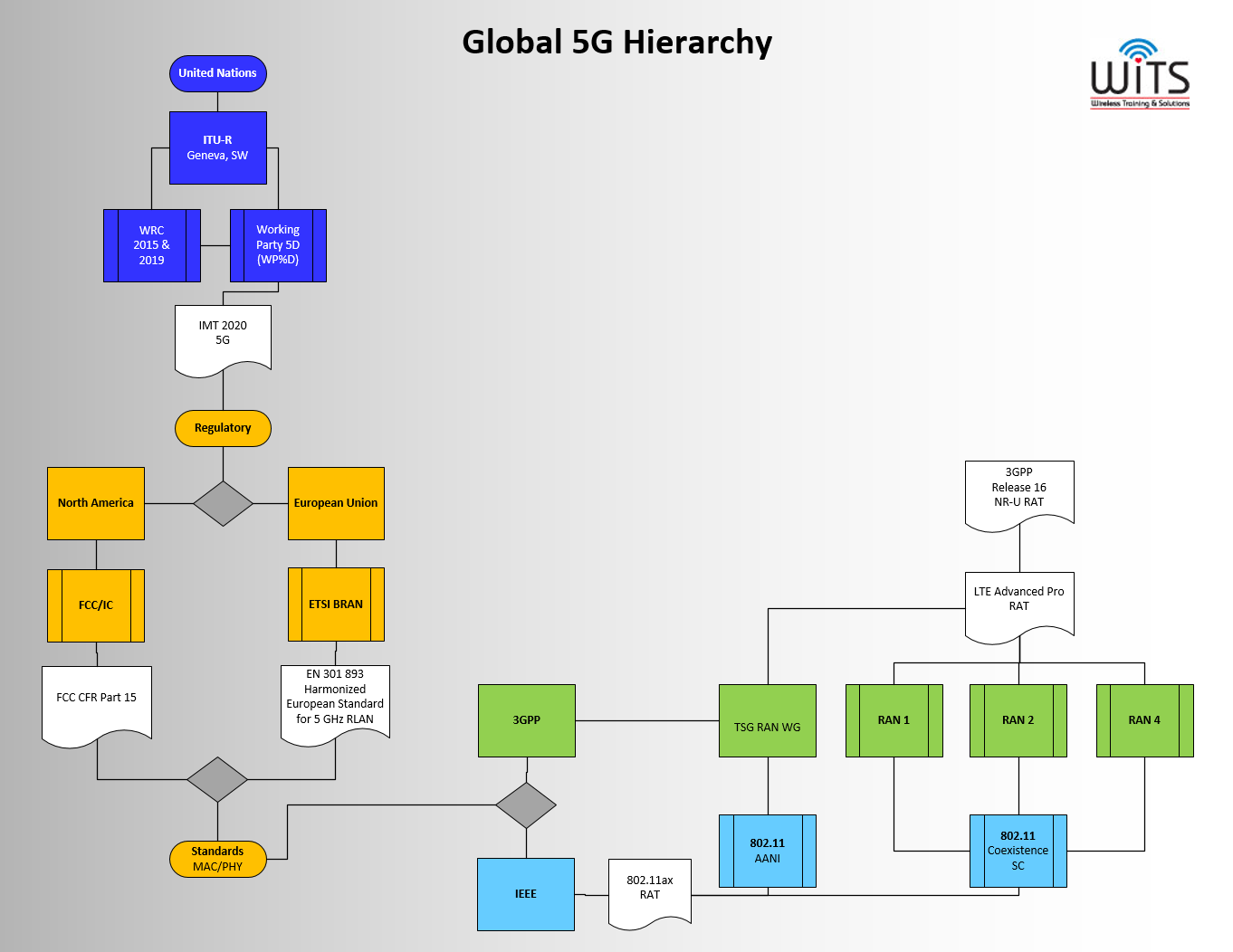
In the hierarchical chart shown above, you can see the order of influence extending downward from the United Nations and its radio regulatory agency known as the ITU-R.
ITU-R sponsors the World Radiocommunications Conferences (WRC) which are held every three to four years. It’s the responsibility of WRC to review, and, if necessary, revise the Radio Regulations, the international treaty governing the use of the radio-frequency spectrum and the geostationary-satellite and non-geostationary-satellite orbits.
- The next WRC is: WRC-19 – 28 Oct – 22 Nov 2019 to be held in Sharm El-Sheikh Egypt
- The last WRC was: WRC-15 – 2 – 27 Nov 2015 – held in Geneva
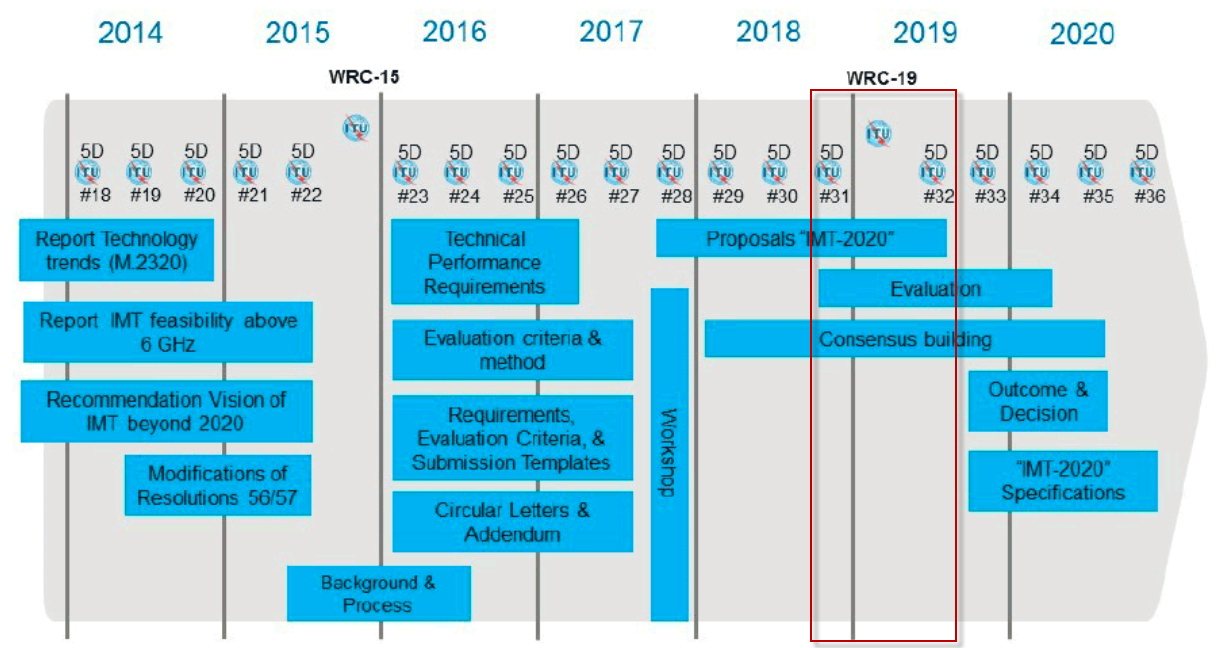
WP 5D Meeting Plan (relevant window in red; #31 Oct. 2018 – #32 July 2019) Source: ITU-R
WP 5D Meetings
ITU-R also sponsors the “Working Party 5D” (WP 5D) committee, which is responsible for the actual development of the IMT generations including IMT-2020. Initial work on IMT-2020 began in 2012. The most recent WP 5D meeting was held in October 2018. The next WP 5D meeting is scheduled for July 2019. It’s believed that the best opportunity for the Wi-Fi community to have a major influence on the development of IMT-2020 and the 3GPP NR-U RAT will be within this window from January 2019 through the WP 5D #32 meeting in July 2019.
IMT-2020 Usage Cases to Compete with Wi-Fi
IMT-2020 will support multi-RAT, including 3GPP’s “New Radio – Unlicensed” and (hopefully) IEEE 802.11ax WLAN technologies. The goal of IMT-2020 is to extend 5G services into new usage cases such as enhanced Mobile Broadband (eMMB), Massive Machine Type Communications (MMTC), and Ultra Reliable and Low Latency Communications (URLLC) that may operate in cotention with traditional Wi-Fi home and business WLANs.
IEEE is ITU-R Member
As shown the IEEE 802.11 Working Group is recognized as a member of ITU-R and a stakeholder in IMT-2020. As such, it can create liaisons with the other non-802.11 working committees, especially the 3GPP groups. Since the 3GPP groups control how the NR-U radios will coexist it’s important to understand this hierarchy as shown next.
3GPP Hierarchy
Development of the 3GPP specifications is done in Technical Specification Groups (TSGs) and Working Groups (WGs). There are three Technical Specifications Groups, each of which consists of multiple WGs.
- RAN (Radio Access Network)
- SA (Service and System Aspects)
- CT (Core Network and Terminals)
The TSG of most interest for this discussion is the 3GPP RAN TSG. This TSG name should not be confused with the network architecture definition of a “radio access network”. The use of the of the term RAN is just the name of the TSG. The RAN TSG is composed of six working groups as shown below, but only RAN 1, RAN 2, and RAN 4 are currently involved in the Wi-Fi coexistence negotiations.
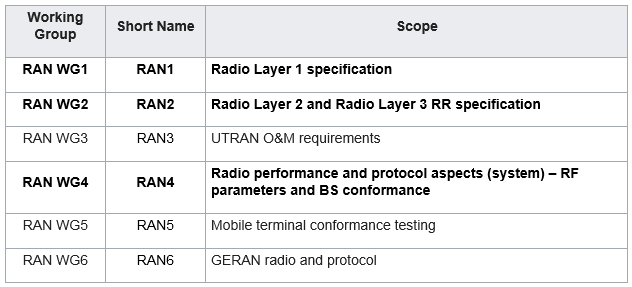
RAN TSG Working Groups Source: Wikipedia
In order to protect the future of Wi-Fi its necessary to interact with these three groups to influence their designs for 3GPP Release 16. While these 3GPP committees have listened politely to the concerns of the Wi-Fi community, and have been cooperative in several areas, there are still many issues that must be harmonized to assure the continuing success of 802.11 WLANs in 5G colocation scenarios.
What’s being done?
Fortunately, the 802.11 WG has created two, advocate Standing Committees (SC) to represent the concerns of the 802.11 WG to the 3GPP. These two 802.11 SCs are the Advanced Access Networking Interface (AANI) Standing Committee (AANI SC) and the Coexistence Standing Committee (COEX SC).
AANI SC – Overview of the roles and goals of the AANI SC
- Advanced Access Networking Interface Standing Committee (AANI SC) –
- The Function of this Standing Committee is to:
- Coordinate and support an IMT-2020 proposal, external proposal
- To generate 802.11 Liaisons to 3GPP RAN to allow for one or more 802.11 RAT(s) to be included in the 3GPP IMT-2020 proposal,
- Coordinate 802.11 activity to enable and support a 3GPP IMT-2020 proposal and specification.
- Coordinate with and support 802.1 (lead) in meeting the actions towards “IEEE 5G” specification
- Encourage review and technical analysis within the WGs
- Consider a common interface
- The Function of this Standing Committee is to:
COEX SC – Overview of the roles and goals of the Coexistence Standing Committee
- Coexistence Standing Committee – (COEX SC)
- The Coexistence SC was formed from the PDED Ad-hoc on 2017-05-12. The scope is:
- Discuss the use of packet detect (PD), energy detect (ED) or other coexistence mechanisms with the goal of promoting “fair access” to unlicensed spectrum for all
- technologies including IEEE 802.11.
- Promote an environment that enables IEEE 802.11ax to have “fair access” to global unlicensed spectrum in the 5GHz band.
- The Coexistence SC was formed from the PDED Ad-hoc on 2017-05-12. The scope is:
Current Status of AANI and COEX SC Efforts
(for detailed coverage of the individual remarks and contributions made by AANI and COEX SCs, see Appendix A – Deep in the Weeds, which can be found below the Summary.)
Both the AANI and COEX Standing Committees have been hard at work reviewing the current ITU-R, ETSI, and 3GPP revisions. They have been providing feedback in the form of Liaison Statements (LS) to the various committees.
In the first half of 2019, several important ETSI, 3GPP, Wi-Fi Alliance (WFA) and 802.11 meetings are scheduled that will determine the extent to which 5G technologies will cooperate with 802.11. This is a critical window for the Wi-Fi community. The future success of WLANs in the 5 and 6 GHz unlicensed bands is at stake. The 802.11 SCs are planning to use this final opportunity to make the case for fair access for all wireless services.
The upcoming meeting schedules for IMT-2020 stakeholders is shown below. The critical window of opportunity is between January and July 2019.
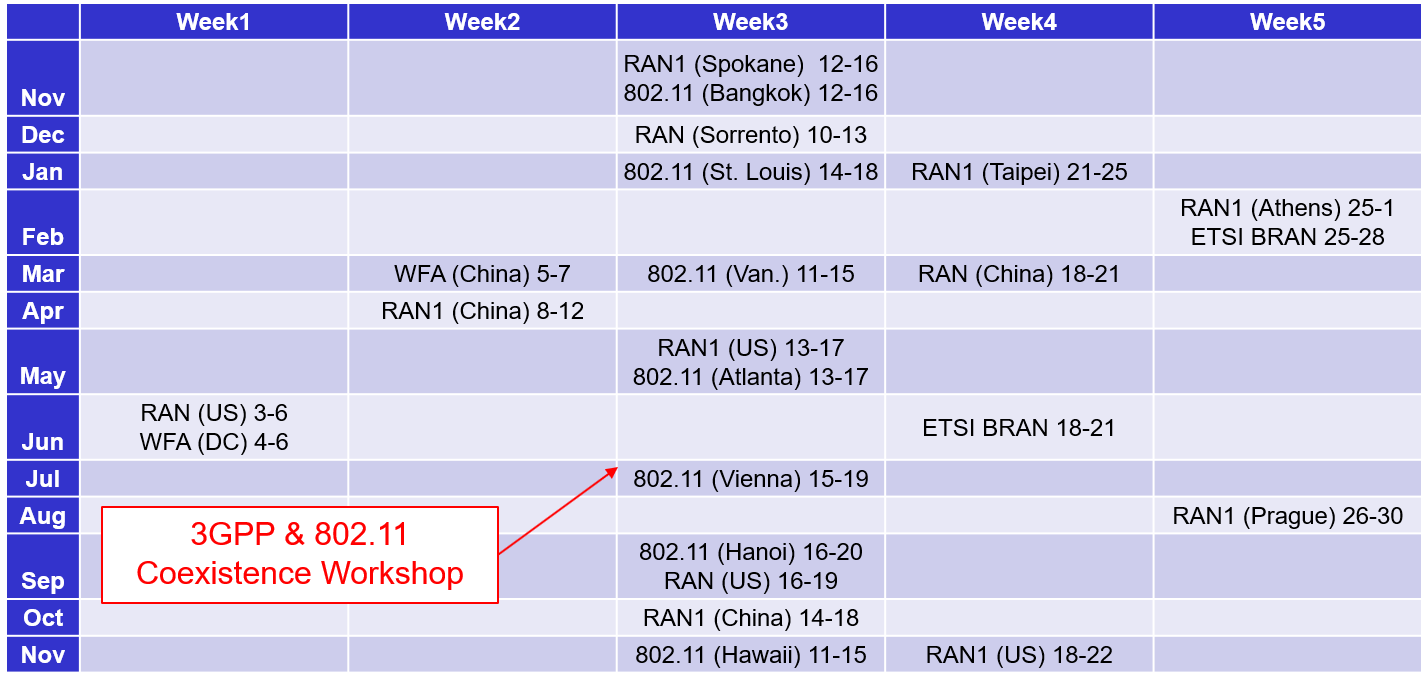
IEEE 802.11, WFA, ETSI, and 3GPP meeting calendar for 2019
3GPP / 802.11 5 GHz Coexistence Workshop
One of the most important events of this timeframe will be the 3GPP/802.11 5 GHz Coexistence Workshop scheduled for July, 2019. This will be used to test and validate the effectiveness of 3GPP coexistence with 802.11 procedures. It has been scheduled to occur during the IEEE 802 plenary meeting in Vienna, Austria. There is some concern that due to the lateness of scheduling this event will happen too late in the process to allow meaningful changes to the NR-U protocol before Release 16 is published, but the 3GPP has assured 802.11 that there will still be time to make any necessary changes.
Tentative 3GPP / 802.11 6 GHz Coexistence Workshop
In addition to the 5 GHz Coexistence Test, the IEEE 802.11 WG sent a liaison statement to 3GPP RAN proposing a joint 6 GHz Coexistence Workshop to enable fair and efficient sharing of the unlicensed spectrum between different technologies. While this workshop has been agreed to in principle, no date has been scheduled at this time
Possible topics for the 6 GHz Workshop include:
- 6 GHz opportunity – 1.2 GHz unlicensed spectrum
- FCC Notice of Proposed Rulemaking (October 2018) includes 5.925-6.425 GHz, 6.425-6.525 GHz, 6.525-6.875 GHz, 6.875-7.125 GHz
- Importance & challenges of fair co-existence in 6 GHz
- No 802.11 or 3GPP incumbents
- 11ax not considered so far by 3GPP (e.g. simulation)
- 11ax not an evolution but a ‘revolution’
- 11ax status / timeline
- Specification, certification, deployment
- What’s next (EHT, FD)
- Salient 802.11ax features (not present in 802.11ac) with possible impact on coexistence (e.g., spatial reuse)
- Simulation scenarios are based 802.11ac & LTE LAA/NR-U
- Fairness criterion
- Wi-Fi/NR-U in 5 GHz and 6 GHz
- Analysis of possible coexistence mechanisms
- g. technology neutral preamble
- LTE LAA/802.11ac field trial results if available
- Agree on a fast communication channel between 3GPP RAN and IEEE 802.11
Summary
Despite the statements of the global cellular industry that LTE-based radio access technologies are good neighbors in the unlicensed radio frequency bands, the Wi-Fi community believes that they create an unfavorable environment when collocated with 802.11 WLANs. This is because the 3GPP Release 13 protocols have an unfair advantage in accessing the medium.
The coming release of IMT-2020 (5G) protocols will push cellular access into new usage cases that are more likely to overlap with incumbent WLANs, than previous use cases.
In order to safeguard the interests of the Wi-Fi community, two advocate subcommittees of the 802.11 Working Group are hard at work representing the views of the WLAN users. AANI is working with 3GPP TSG RAN to verify 802.11ax compliance with the IMT-2020 specification, in an effort to receive approval as a 5G RAT. And COEX SC is working with 3GPP RAN 1, RAN 2, and RAN 4 to try to assure that fair access to the unlicensed bands is not degraded by the operations of 3GPP New Radio – Unlicensed radio access technology.
A flurry of important meeting and workshops between most of the major stakeholders in this effort are scheduled to occur between January and July of 2019. The results of these conferences are likely to have a major effect of both Wi-Fi and 5G implementations for many years to come.
Although, this is the final, planned chapter in the Future-Fi series, you can expect to see ongoing updates to all these issues as the future of Wi-Fi unfolds.
Thanks for reading!
Appendix A – Deep in the Weeds
AANI SC Status as of November 2018
Contributions regarding AANI SC testing related to 802.11ax / IMT-2020 performance.
- AANI SC Historical Contributions addressing 802.11ax performance relative to the IMT-2020 EMBB requirements:
- 11-18/0256r0 “802.11ax for IMT-2020”
- 11-18/0517r0 “802.11ax for IMT-2020 eMBB Indoor Hotspot and Dense Urban”
- 11-18/0915r1 “Benchmarking of 802.11ax against eMBB Indoor Hotspot requirements using IMT-2020 simulation methodology”
- 11-18/1240r0 “802.11ax for IMT-2020 eMBB Indoor Hotspot”
- 11-18/1573r1 “Summary of 802.11ax Self Evaluation for IMT-2020 EMBB Indoor Hotspot and Dense Urban Test Environments”
- 11-18/1340r2 “Proposed LS to 3GPP/WFA/WBA/WifiForward on the studies done regarding benchmarking of 802.11ax capabilities”
New contributions addressing 802.11ax performance relative to the IMT-2020 EMBB requirements:
- 11 technical performance relative to IMT-2020 requirements
- 11-18/1573r3 – “Summary of 802.11ax Self Evaluation for IMT-2020 EMBB Indoor Hotspot and Dense Urban Test Environments – updated to r4
- 11-18/0915r2 – “Benchmarking of 802.11ax against eMBB Indoor Hotspot requirements using IMT-2020 simulation methodology”
- 11-18/1240r3 – “802.11ax for IMT-2020 eMBB Indoor Hotspot”
COEX SC Status as of November 2018:
- In June 2017, the COEX SC submitted a request to ETSI BRAN regarding the use of dual threshold option (Preamble Detect/Energy Detect)
- Comments:
- 11 WG notes that fair sharing can occur (mostly) if equipment use both PD/ED (eg 802.11) and ED-only (eg LAA) mechanisms
- Other simulations have highlighted that fair sharing does not occur when 802.11ax is forced to use the same ED threshold as used by the LAA defined ED-only mechanism
- 11ax will have less performance than both 802.11ac and LAA in this situation
- 11 WG observes that the current version of EN 301 893 allows the use of PD/ED mechanism by existing versions of 802.11 but not the future version, 802.11ax
- Current status:
- Good news. Basic adaptivity clause is agreed upon, allowing use of either ED-only or PD/ED mechanisms by all technologies
- This should mean that 802.11ax will be allowed by ETSI
- In November 2018, the COEX SC submitted a request to ETSI BRAN regarding the issue of “Blocking Energy”
- Comments:
- The current situation is that some vendors’ LAA equipment will transmit up to 0.5ms of what is essentially unnecessary noise at the start of every COT for the sole purpose of blocking access to the medium to other devices. This use of blocking energy by some LAA devices will cause interference to other devices attempting to use the medium, including IEEE 802.11 devices, and yet is not required for good performance of LAA according to 3GPP RAN1.
- IEEE 802.11 WG requests that ETSI BRAN take IEEE 802’s position into account when deciding how to deal with the blocking energy In particular, IEEE 802.11 WG requests that ETSI BRAN consider the viability of various options for strongly discouraging or even banning, the use of blocking energy by LAA devices (as well as other devices) and restricting its length in the event blocking energy is used.
- This is like a problem resolved in Sept 2018 in which it was discovered that an un-named LAA vendor continued blocking the channel after LAA had completed its transmissions which effectively disabled Wi-Fi access to the channel. This specific use of blocking energy has since been disallowed.
- Comments:
- Comments:
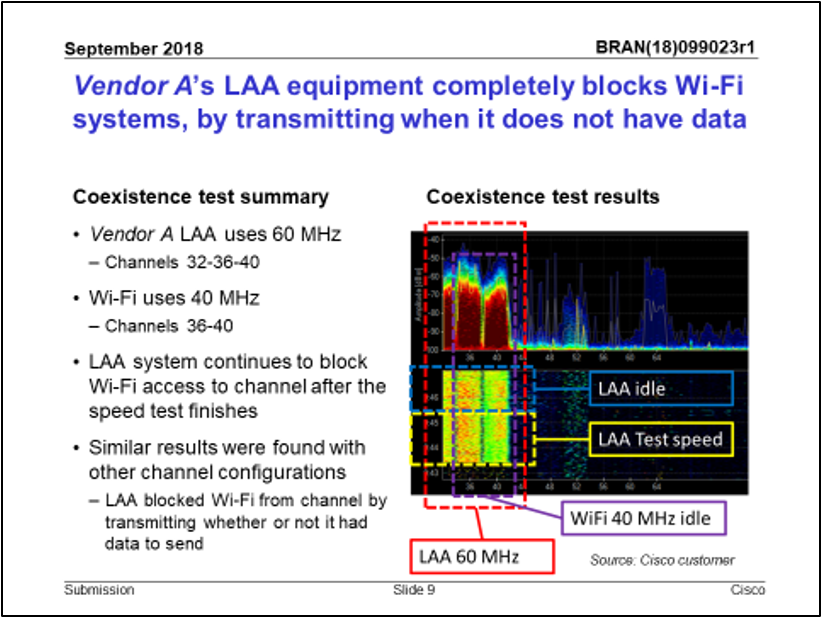
Use of Blocking Energy to prevent Wi-Fi from accessing channel
- Current status:
- Blocking Energy continues after LAA transmission completes – resolved
- Blocking Energy used prior to LAA transmission – unresolved in EN 301 893 v2.1.1
- As of November 2018, the COEX SC is in discussions with 3GPP RAN1 concerning the following topics:
- Topic: No-LBT or 25us LBT for transmission of control messages in NR-U
- Comment: NR-U control messages are transmitted over the unlicensed carrier(s).
- Most companies in 3GPP RAN1 favor transmitting these control messages either without LBT (unfortunately such transmission without LBT for up to 5% of the time is allowed per device by ETSI-BRAN) or with only 25us LBT.
- This poses a grave coexistence risk to 802.11 where almost all messages on the primary channel are transmitted using Cat 4 LBT. These messages include beacons, probe/association request and response messages for which the equivalent messages in NR-U are being proposed to be transmitted without LBT or 25us LBT.
- The only messages transmitted in 802.11 with 25us LBT are the Traffic Indication Map (TIM) and Channel Switch Announcement (CSA) messages. The transmission of such messages is significantly less than 1% per AP.
- Comment: NR-U control messages are transmitted over the unlicensed carrier(s).
- Topic: No-LBT or 25us LBT for transmission of control messages in NR-U
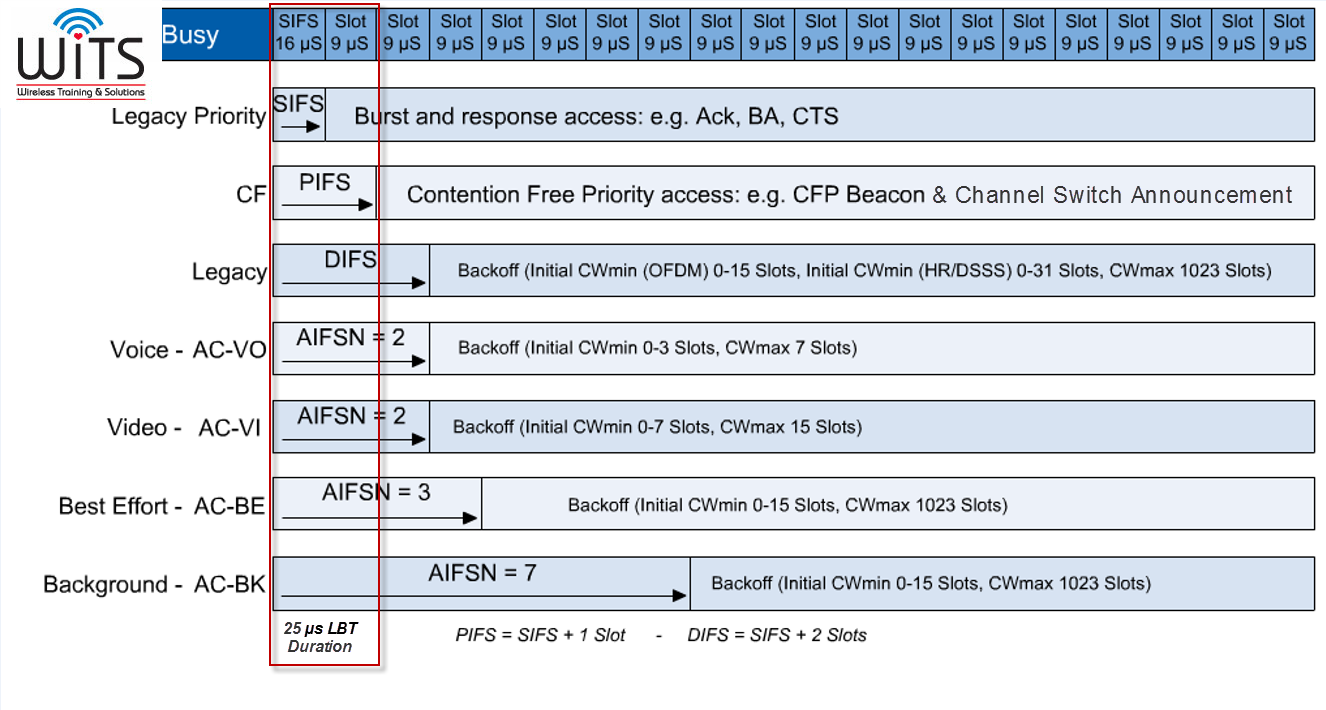
3GPP LBT Duration vs. 802.11 Interframe Space Timings
- Status: Unresolved as of November 2018
- Topic: Simulation configuration for Outdoor sub-7GHz for NR-U
- Comment:
- Many companies proposed a network deployment where the relevant gNodeB-AP links are all above -72dBm.
- However, deployed 802.11 network data (presented by Broadcom in 3GPP and collected by Cisco, CableLabs and HPE) have shown that a significant percentage of such AP-AP links can be below -72dBm and so NR-U (or LAA) deployments in such a network will introduce a significant percentage of hidden nodes.
- For this reason, Broadcom proposed an additional configuration where about 10-15% of the AP-gNodeB links are below -72dBm and about 20% of the AP-UE links are below -72dBm.
- The latter metric ensures that NR-U coexistence is additionally evaluated in the presence of weak 802.11 links.
- There was very significant opposition in RAN1 to including such a network deployment for coexistence evaluations.
- Status: Broadcom and CableLabs were ultimately able to get the above configuration agreed.
- Comment:
- Topic: Adoption of 802.11a preamble
- Comment:
- In RAN1#93 the following was agreed in the NR-U frame structure discussion:
- Benefits of using a signal that facilitates its detection with low complexity can be investigated including all/part of the following scenarios/use cases:
- UE power saving
- Improved coexistence
- Spatial reuse at least within the same operator network
- Serving cell transmission burst acquisition
- FFS: further usage scenarios
- In RAN1 #94, there was further discussion. Intel, Broadcom and Apple proposed the explicit inclusion of 802.11a preamble as one of the candidates. Companies led by Ericsson opposed considering the 802.11a preamble.
- Some text was formulated in offline discussions which would have listed 802.11a preamble as one of the candidates to be evaluated for the above benefits. However, it was not agreed eventually.
- Even then, there is much more support for this feature than during LAA standardization.
- AT&T has also expressed interest in an evaluation of the coexistence benefits of NR-U using the 802.11a preamble as well as the complexity of implementing the 802.11a preamble within the NR waveform.
- Status: The discussion is still open.
- Comment:
- As of November 2018, the COEX SC is in discussions with 3GPP RAN2 concerning the following topic:
- Topic: Start of NR-U standardization
- Comment:
- RAN2 has also started working on NR-U standardization.
- It will look at MAC and higher layer aspects of NR-U
- Status:
- Even though the standardization effort in RAN2 is lower than RAN1 (which is the lead working group for NR-U), it is useful to have a delegate representing 802.11 interests in RAN2.
- As of November 2018, the COEX SC is in discussions with 3GPP RAN4 concerning the following topics:
- Topic: Invalid band combinations in LAA
- Comment:
- Overview: The LAA standards specify that if the maximum number of channels that LAA can simultaneously transmit is <= 4, the maximum frequency separation between the center frequencies of any two carriers should be <= 62MHz. This clause has been put to ensure fair coexistence with 802.11 multi-carrier transmissions that use a fixed “channel bonded” structure as shown below.
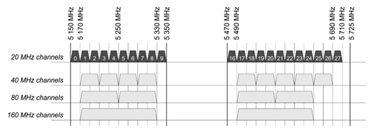
- The following are the adverse consequences to 802.11 if LAA was allowed to carrier aggregate channels in an unrestricted manner while using the LBT scheme similar to 802.11:
- LAA multicarrier transmission of a given bandwidth can restrict 802.11 multicarrier transmissions over a much wider band. For example, if one 80 MHz LAA transmission consisting of four 20 MHz carriers is allowed in an unrestricted non-contiguous manner, it can block transmissions on two 802.11 80 MHz channels or four 802.11 40 MHz channels, even though it uses only 80 MHz of the total 160 MHz spectrum. On the contrary, as noted earlier, 802.11 multicarrier transmission on 80 MHz can block other 802.11 multicarrier transmissions only over the given 80 MHz and no more.
- LAA can choose multiple primary 802.11 channels to carrier aggregate and also to use them as its own secondary channels. This will result in unfair priority sharing between Wi-Fi and LAA.
- To prevent this, the following clause was put in the LAA specification “the maximum frequency separation between any two carrier center frequencies on which LAA SCell transmissions are performed should be less than or equal to 62MHz”
- However, 3GPP RAN4 (the working group responsible for defining band configurations and performance requirements) has defined band combinations for LAA multi-carrier transmission that violate the above coexistence clause in the LAA standard.
- After much discussion, RAN4 agreed to mandate a multi-carrier transmission scheme for LAA DL which follows the 802.11 bonded multi-carrier transmission scheme if the LAA multi-carrier LBT scheme is the same as 802.11.
- However, the RAN4 agreement is now being challenged by Nokia in the ongoing RAN Plenary (RAN#81, Sep 10-13, 2018).
- Status:
- The discussion on this challenge may happen on 13/Sep and companies may try to roll back the agreement to the detriment of fair coexistence between LAA and 802.11.
- Comment:
- Topic: Invalid band combinations in LAA
- Comment:
- Topic: Start of NR-U standardization
Leave a Reply